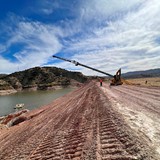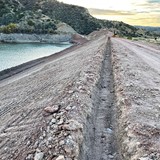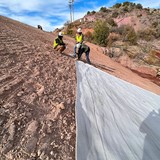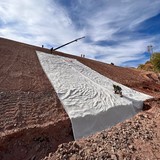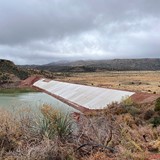Solving Time & Installation Challenges for Mine Site
RCR-7® | Mine Tailings Pond
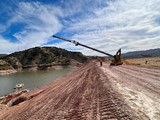
Tailings Dam Site Preparation
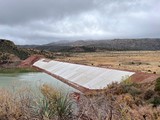
Completed RCR® for Tailings Dam
Project Objectives Using Reinforced Concrete Roll®
PROJECT OVERVIEW
ITL RCR-7® was chosen to line the freshwater side of a tailings pond at a mine site in Arizona. A failing buried liner system along the face of the berm, which separates fresh water from dried tailings, was raising concern. Also of concern was the high-winds prevalent at the location, contributing to erosion control issues.
PROJECT GOAL
Cover one side of the tailings pond to prevent water from penetrating the center berm. This protection was essential for the water containment critical to the mining process.
PRE-EXISTING SITE CONDITIONS:
- High elevation of the mine: 4,000 feet (1,220 meters)
- Existing liner buried underneath the face of the slope
- High winds area requiring stable slope protection able to resist wind damage and lifting
- Installation during cold/damp months of November and December
Critical Pre-Planning Shows Exact Panel layout

Applying RCR-7® To Armor Tailings Dam Slope
Over 120,000 ft2 of Reinforced Concrete Roll® was installed safely, rapidly, and without any enhanced training or specialty tools. The length of this slope was roughly 106 feet (32.3m), and the angle was approximately 2:1. Installation did require a crane and spotter, as the crane lowered the product for unrolling from behind the berm on the dry tailings pond, nearly 20 vertical feet below the top of the berm.
Alternatives considered included a geomembrane liner and traditional concrete. Geomembrae was ruled out in favor of the customer's need for a more robust option to provide erosion control. This option was also bypassed for potential construction delays in the high-wind area and the potential for repeated future repair. Traditional concrete was ruled out as a solution due to increased cost and difficult installation based on the slope angle and length.
Site challenges for this large project included inclement weather (snow and excess rainfall); however, due to the ease of application, the budget and timeline remained intact.
Given the lenthg of the slope of 106 feet (32.3m), and length of the rolls ~65.4 feet (20m), roughly 1.6 rolls were required from the top anchor trench to the bottom anchor trench. The joint connecting the two rolls was created approximately one-quarter of the way down the slope, overlapped ~1 foot (.3m), with the top edge of the bottom RCR® being pinned in place using 6" long U-pins, spaced every 3 feet (1m). The anchor trench at the top was 2' deep and 2' wide, set back ~3'. The bottom anchor trench was 2' deep and 2' wide. The sides were also terminated using an anchor trench 2' deep and 2' wide.
Although this project was budgeted for 23 working days, the entire installation was completed in less than 20 working days. This includes lost time due to equipment issues, high winds, rain, and snow.
Ask for a product sample or speak to one of our experts.
Leo Cortez | Product Manager
Cell: (509) 770-0602
Email: leoc@inlandtarp.com

